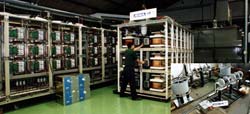Sources of energy for the EFDA-JET nuclear fusion experimental reactor

JEMA, the company based in Lasarte in the Basque Country, has recently put into operation the two energy supply plants designed and manufactured for the European EFDA (the European Fusion Development Agreement)-JET nuclear fusion experimental reactor at Culham in the United Kingdom. This reactor is one of the plants on which ITER, the largest research project in the world, has been based.
With this achievement JEMA has carried out more than 2 years of intense work in research, design and construction of equipment which is at the latest available technological cutting edge of what is possible in manufacturing today.
Each supply plant produces 20 million watts (approximately 10% of the energy produced at the power station at the Basque port of Pasaia) using 130,000 volts d.c. power supply at 130 amperes, with high quality and precision specifications: less than 1,000 volts of error; 150 microseconds rising ramp and 7 microseconds falling ramp.
To achieve the specifications required it has been necessary to develop a very wide variety of innovative elements and configurations (260,000 volt insulating transformers, crowbars, DSP control, refrigeration systems for water, etc.), which have required the joint working across a number of research centres.
Some interesting data: each energy supply installation occupies a surface area of approximately 400 m2 and needed 9 specialised lorries for their transport to the U.K. and the factory-based trials required a modification of its electric supply with new, high-tension cables being erected across the N-1 highway and over the river Oria.
The contract for these energy supply installations was awarded to JEMA by the European Commission, commissioned by EFDA and against keen competition from big multinationals in the sector. More than 25 years of international experience at JEMA developing specialised electrical supply equipment for nuclear and particle physics research laboratories has made this possible.
It is also worthy of mention the fact that in 2003 JEMA developed an plant prototype for the LHC (Large Hadron Collider) experiment, the world’s largest particle accelerator currently under construction at CERN (European Centre for Nuclear research), in Geneva (Switzerland).
Notes
More information:
Juan Otegi
Commercial Manager
jema@grupojema.com
tel: (+34) 943376400
Fax: (+34) 943371279
Media Contact
All latest news from the category: Power and Electrical Engineering
This topic covers issues related to energy generation, conversion, transportation and consumption and how the industry is addressing the challenge of energy efficiency in general.
innovations-report provides in-depth and informative reports and articles on subjects ranging from wind energy, fuel cell technology, solar energy, geothermal energy, petroleum, gas, nuclear engineering, alternative energy and energy efficiency to fusion, hydrogen and superconductor technologies.
Newest articles

NASA: Mystery of life’s handedness deepens
The mystery of why life uses molecules with specific orientations has deepened with a NASA-funded discovery that RNA — a key molecule thought to have potentially held the instructions for…

What are the effects of historic lithium mining on water quality?
Study reveals low levels of common contaminants but high levels of other elements in waters associated with an abandoned lithium mine. Lithium ore and mining waste from a historic lithium…

Quantum-inspired design boosts efficiency of heat-to-electricity conversion
Rice engineers take unconventional route to improving thermophotovoltaic systems. Researchers at Rice University have found a new way to improve a key element of thermophotovoltaic (TPV) systems, which convert heat…



